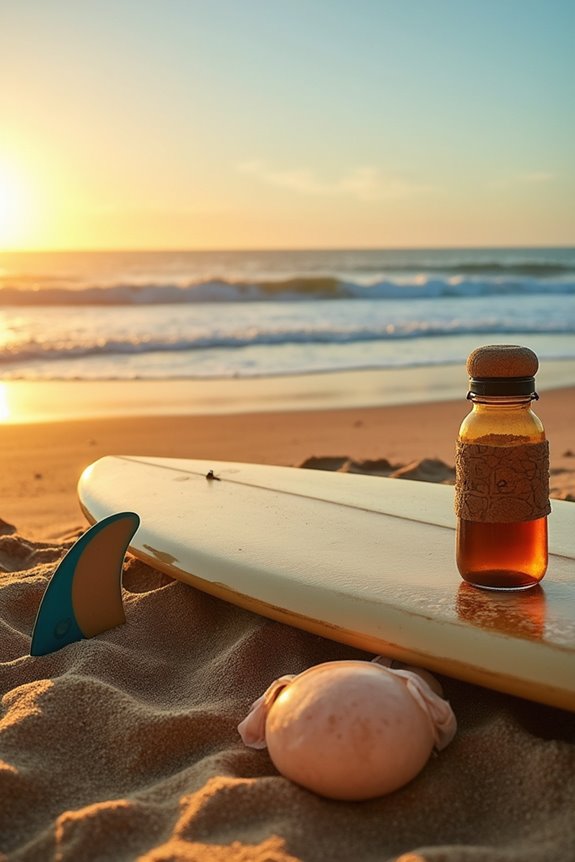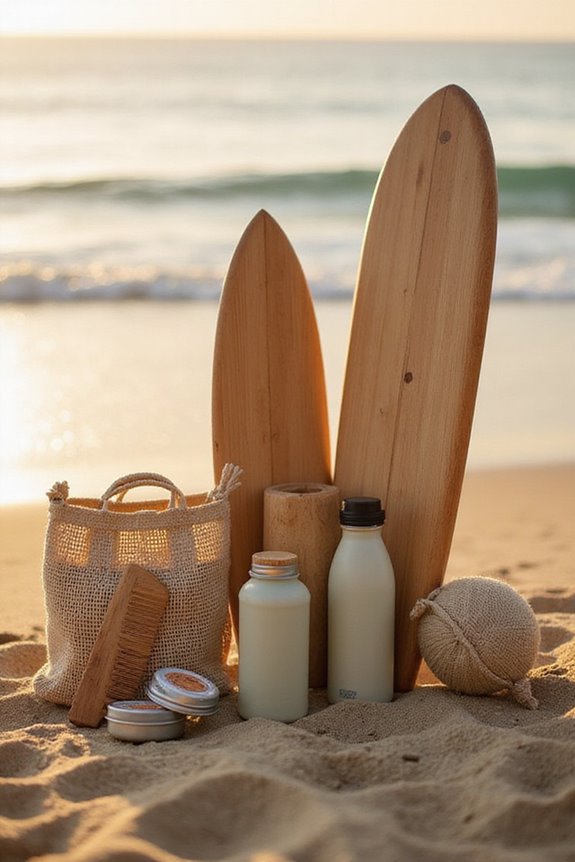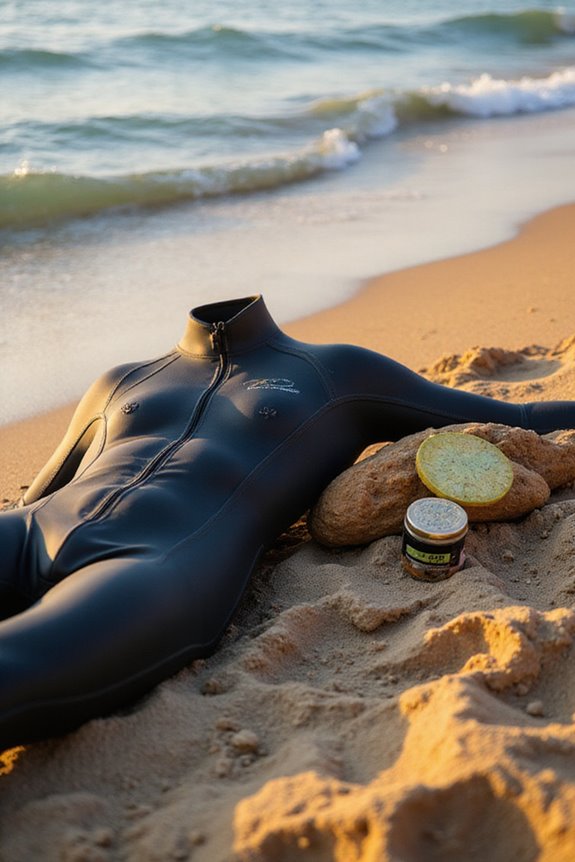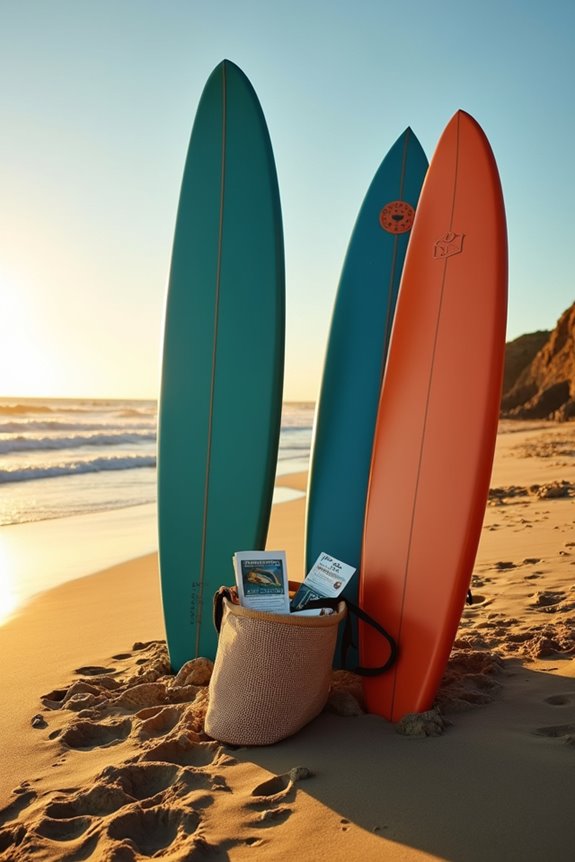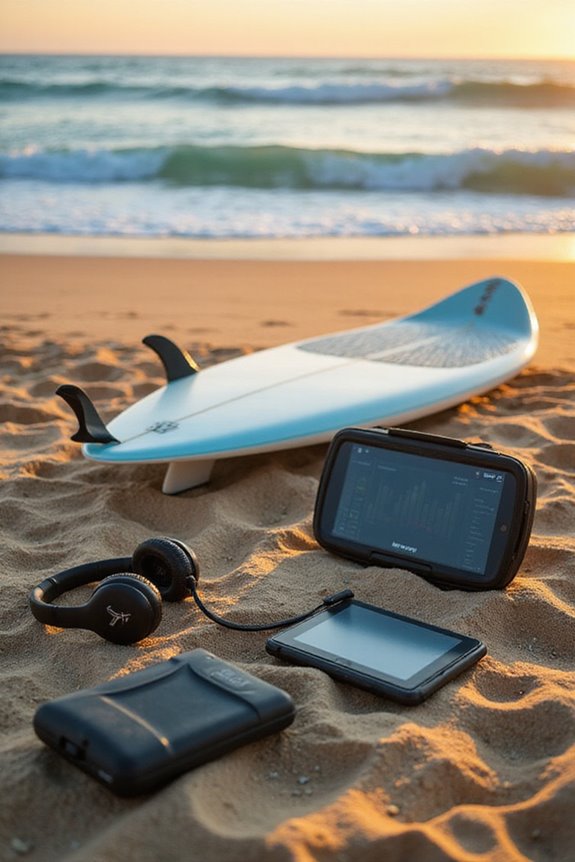To surf more sustainably, we should choose eco-friendly equipment like wetsuits made from natural rubber, and support brands with recycling programs. We can also travel responsibly by selecting green accommodations and minimizing single-use plastics during our trips. Supporting local conservation efforts and participating in beach clean-ups helps protect our coastal ecosystems. Finally, we can advocate for policies that limit pollution. With these actions, we contribute to healthier surf environments. There’s more we can explore together.
Key Takeaways
- Choose sustainable surf equipment, like eco-friendly wetsuits made from natural rubber or limestone-based neoprene, to reduce environmental impact.
- Plan eco-friendly surf trips by selecting local accommodations and minimizing flights to lessen your carbon footprint.
- Participate in community beach clean-ups to help remove litter and promote coastal conservation efforts.
- Support local conservation organizations to protect surf ecosystems and engage in initiatives that promote marine biodiversity.
- Reduce single-use plastics during your surf outings by using reusable containers and avoiding disposable items.
Understanding the Environmental Impact of Surfing
When we consider the environmental impact of surfing, it’s essential to recognize the interconnectedness of our beloved surf spots and the surrounding ecosystems. The surf ecosystem is often surrounded by carbon-rich environments, like coastal forests and mangroves, which store significant amounts of carbon—about 950 million metric tons globally. Unfortunately, these critical ecosystems face threats from pollution, habitat destruction, and climate change, impacting both marine conservation and our surfing communities.
Increased human activity at popular surf spots leads to coastal erosion, which threatens local wildlife habitats and biodiversity. By understanding these issues, we can work towards protecting our surf environments, ensuring they remain healthy and vibrant for future generations, while also supporting marine conservation efforts. To enhance our surfing experience and minimize our impact, we should prioritize essential surfing gear that promotes sustainability and reduces environmental harm.
Choosing Sustainable Surf Equipment and Apparel
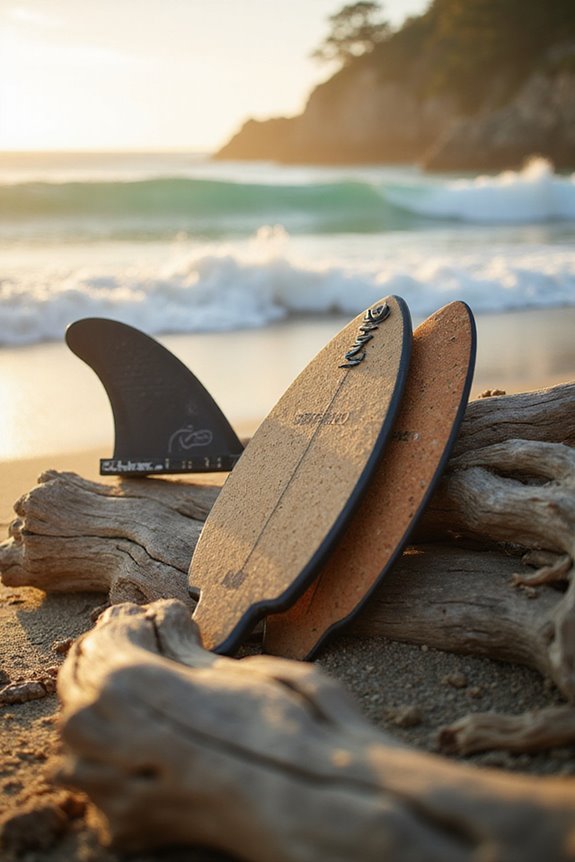
When it comes to eco-friendly wetsuits, we should consider alternatives like limestone-based neoprene or Yulex natural rubber. These options perform well while being more sustainable than traditional materials. Additionally, brands are increasingly adopting non-toxic adhesives and recycling programs for old wetsuits. By choosing these sustainable options, we can enjoy surfing while protecting the oceans we love. Furthermore, looking for wetsuits with sustainable materials can further enhance our eco-conscious choices in surfing gear.
Embracing Eco-Friendly Surf Travel Practices
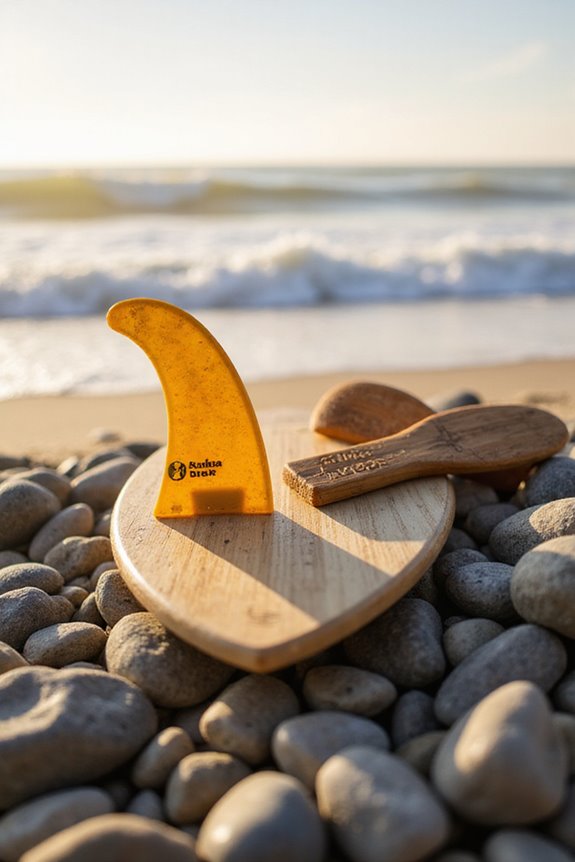
Embracing eco-friendly surf travel practices can greatly enhance our surfing experience while minimizing our impact on the environment. By choosing eco-friendly accommodations, like those certified for sustainable practices, we reduce our carbon footprint. Supporting local, small-scale operators fosters community economies and limits overdevelopment.
When it comes to transportation, opting for sustainable transportation methods, such as trains or shared rides, considerably lowers emissions compared to flights. Planning trips during off-peak seasons helps reduce overcrowding at surf spots, preserving their natural beauty.
Additionally, minimizing single-use plastics by using reusable containers can decrease waste at our favorite surf locations. By making these responsible choices, we can enjoy our surf trips while caring for the environment. Furthermore, selecting reef-safe options for sunscreen not only protects our skin but also helps preserve marine life during our surf adventures.
Supporting Local Conservation Efforts
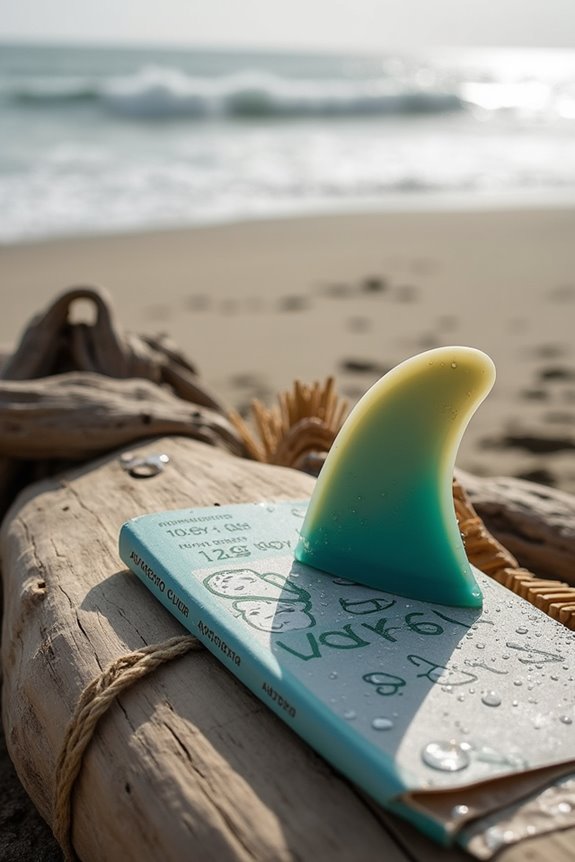
How can we, as surfers, contribute to the preservation of our favorite surf spots? One effective way is through supporting local conservation organizations. These groups often lead initiatives to establish Surf Protected Areas, protecting crucial ecosystems like coral reefs and mangroves. By forming local partnerships, we can amplify their impact at surf destinations.
We can also engage with these organizations by volunteering or donating, which helps advance community-based coastal protection and habitat restoration. Additionally, participating in education programs raises awareness about marine biodiversity and sustainable tourism. By backing policies that limit pollution and overfishing, we help guarantee the health of our surf spots for future generations, fostering both ecological integrity and local economic benefits. Supporting these initiatives can also enhance the stability of surf ecosystems, ensuring that they thrive alongside our surfing activities.
Participating in Community Beach Clean-Ups
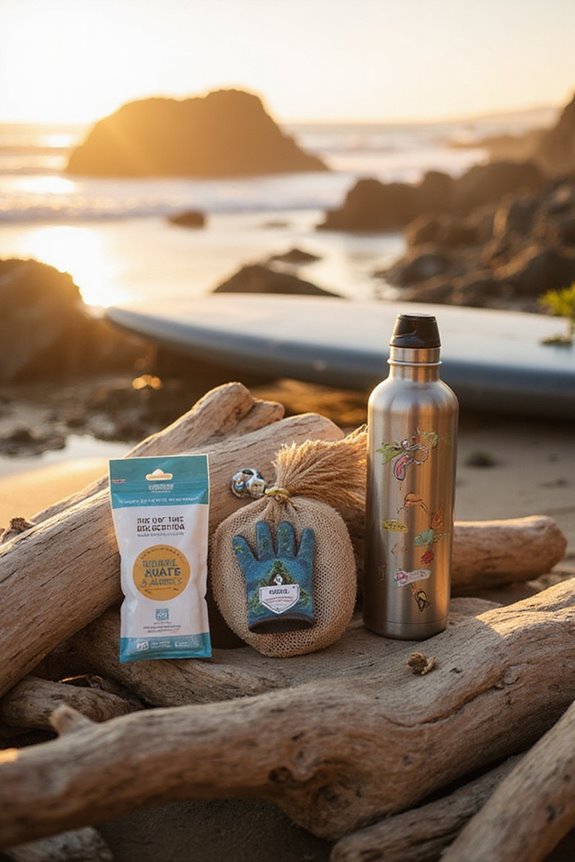
Participating in community beach clean-ups offers us a practical way to protect our coastal environments while fostering a sense of responsibility. By joining these events, we engage in community involvement and contribute to a cleaner, healthier ocean. For instance, organizations like the Surfrider Foundation mobilized over 34,600 volunteers in 2023, removing 225,000 pounds of trash nationwide.
Moreover, these clean-ups collect valuable litter data, helping us understand pollution sources and advocate for change. This data not only tracks the most common litter items, primarily single-use plastics, but also supports evidence-based policies. Ultimately, our participation in clean-ups enhances local stewardship, raises awareness about marine litter, and inspires a collective commitment to sustainability in our surfing communities. Additionally, local surf schools promote environmental stewardship by encouraging surfers to participate in such initiatives.
Reducing Your Carbon Footprint as a Surfer
Reducing our carbon footprint as surfers is crucial for the sustainability of our beloved ocean environments. We can start by choosing surfboards made from sustainable materials, like recycled foams and biodegradable components, which greatly lower emissions during production. Additionally, we should consider the lifespan of our gear; opting for durable wetsuits and boards reduces the frequency of replacement, cutting down waste.
Transportation choices also play an essential role. Instead of flying frequently for surf trips, we can explore closer destinations or carpool with fellow surfers. Finally, engaging in carbon offsetting initiatives helps balance our emissions, ensuring we contribute positively to the coastal ecosystems we cherish. Collectively, these actions can make a meaningful difference in our surfing impact. Furthermore, using organic surf wax can reduce the negative impact on marine ecosystems while enhancing our surfing experience.
Advocating for Sustainable Surfing Initiatives
Advocating for sustainable surfing initiatives is essential if we want to protect our oceans and surf culture. By supporting sustainable competitions, we can raise awareness and promote eco-friendly practices. Events like the Rip Curl Pro Bells Beach enforce plastic-free policies, while the Vans Triple Crown partners with local organizations for marine conservation.
We can also engage in eco-friendly partnerships, collaborating with surf schools and environmental groups. These alliances amplify our impact through citizen science and community involvement. Together, we can participate in beach clean-ups, removing harmful debris and fostering environmental responsibility. By promoting these initiatives, we not only enhance our surfing experience but also contribute to the health of our oceans for generations to come.
Frequently Asked Questions
How Can I Influence Others to Surf Sustainably?
Like a wave crashing onto the shore, we can amplify our impact through community engagement and social media. Let’s share our sustainable practices, inspire others, and create a movement that encourages eco-friendly surfing for everyone.
Are There Certifications for Sustainable Surf Schools?
Yes, there are eco certification programs for sustainable surf schools, like STOKE, which assess their practices in management, community support, and environmental impact. We should look for these certifications when choosing where to surf responsibly.
What Are the Best Eco-Friendly Surf Brands?
We’ve found some fantastic eco-friendly surf brands using sustainable packaging and materials. Brands like Patagonia and Firewire lead the way, showcasing innovative approaches that help us enjoy surfing while protecting our oceans and environment.
How Do I Maintain My Surf Gear Sustainably?
We’ve all faced that moment when our gear needs a little TLC. By adopting simple gear cleaning habits and following repair tips, we can extend our surfboards’ life while enjoying our time in the waves.
Can Sustainable Surfing Practices Save Me Money?
Absolutely, sustainable surfing practices can save us money! By choosing cost-effective alternatives like local spots and durable gear, we’re embracing budget-friendly tips that not only reduce expenses but also support our environment and surf communities.

